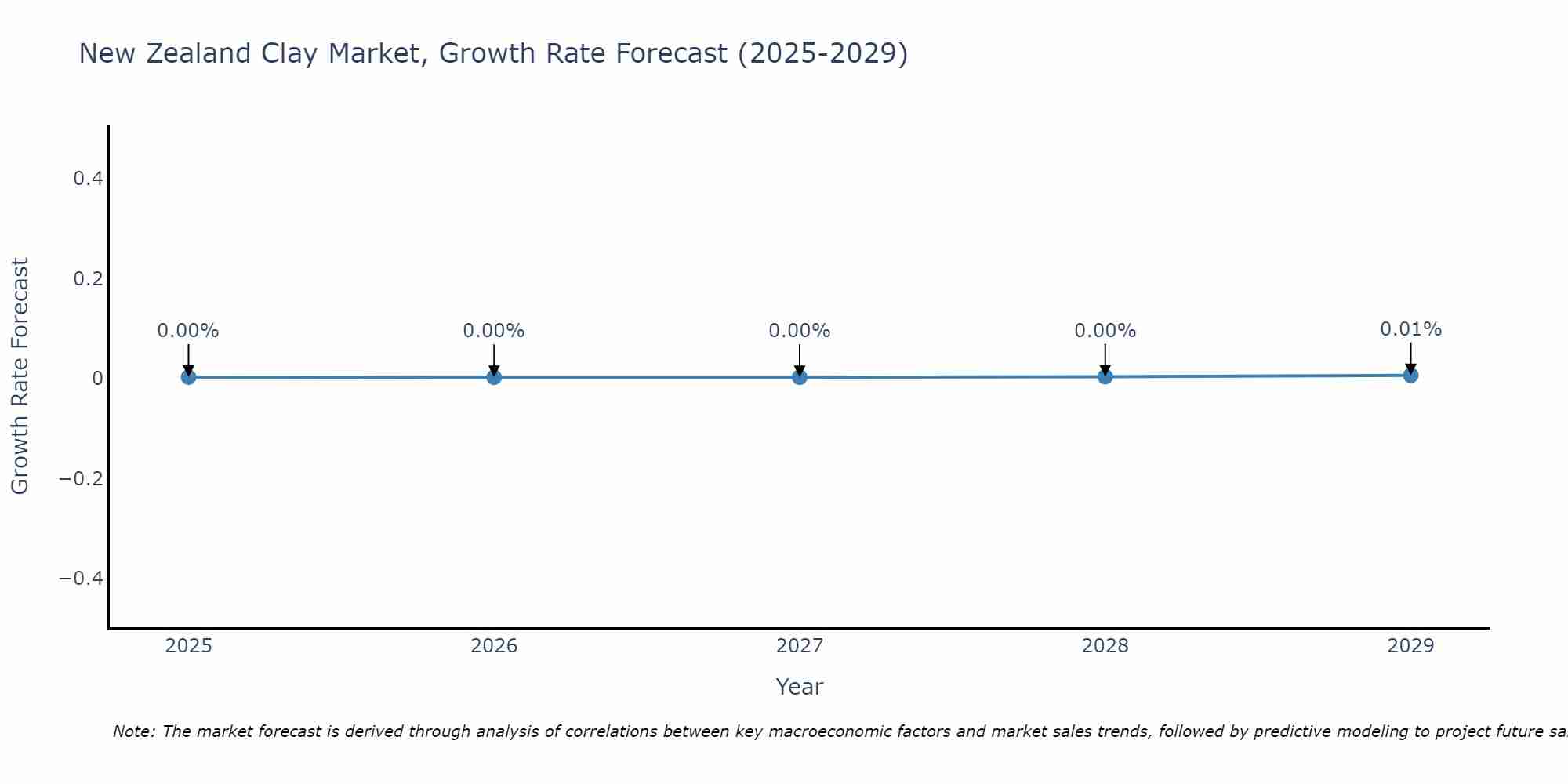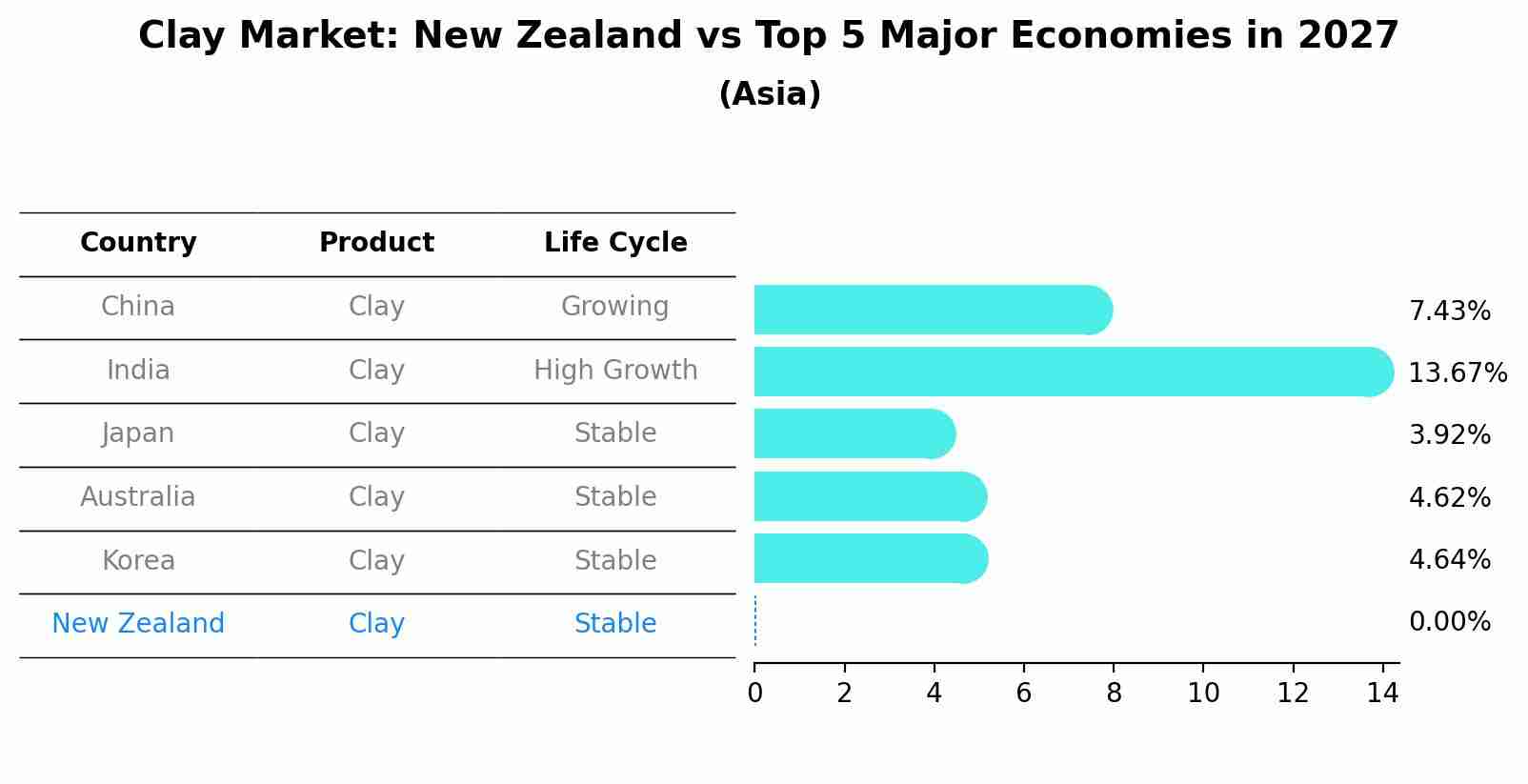New Zealand Clay Market (2025-2031) | Industry, Companies, Outlook, Revenue, Segmentation, Share, Analysis, Trends, Growth, Size, Value & Forecast
| Product Code: ETC5257701 | Publication Date: Nov 2023 | Updated Date: Sep 2025 | Product Type: Market Research Report | |
| Publisher: 6Wresearch | Author: Bhawna Singh | No. of Pages: 60 | No. of Figures: 30 | No. of Tables: 5 |
New Zealand Clay Market Size Growth Rate
The New Zealand Clay Market is projected to witness mixed growth rate patterns during 2025 to 2029. Commencing at 0.00% in 2025, growth builds up to 0.01% by 2029.

Clay Market: New Zealand vs Top 5 Major Economies in 2027 (Asia)
New Zealand's Clay market is anticipated to experience a stable growth rate of 0.00% by 2027, reflecting trends observed in the largest economy China, followed by India, Japan, Australia and South Korea.

New Zealand Clay Market Overview
New Zealand clay and refractories market plays a crucial role in supporting various industries, including construction, ceramics, and metallurgy. The demand for clay products and refractories is influenced by factors such as infrastructure development, urbanization, and industrial expansion. Manufacturers in this sector are constantly innovating to enhance product performance, durability, and sustainability to meet the evolving requirements of end-users.
Drivers of the market
Clay is a versatile material with applications ranging from construction and ceramics to cosmetics and pharmaceuticals. In New Zealand, the clay market is influenced by factors such as infrastructure development, urbanization, and the construction industry`s demand for raw materials. Additionally, the growing popularity of handmade pottery and artisanal ceramics is contributing to the growth of the clay market.
Challenges of the market
Challenges within the New Zealand clay market revolve around sourcing quality clay reserves and managing environmental impacts associated with extraction and processing. Competition from alternative materials and fluctuations in construction and manufacturing demand further contribute to market uncertainties.
Government Policy of the market
The New Zealand clay market is regulated to ensure sustainable extraction practices and environmental protection. Government agencies oversee clay mining operations to minimize environmental impact and promote rehabilitation of mining sites. Quality standards are in place to maintain the suitability of clay for various industrial and commercial applications.
Key Highlights of the Report:
- New Zealand Clay Market Outlook
- Market Size of New Zealand Clay Market, 2024
- Forecast of New Zealand Clay Market, 2031
- Historical Data and Forecast of New Zealand Clay Revenues & Volume for the Period 2021-2031
- New Zealand Clay Market Trend Evolution
- New Zealand Clay Market Drivers and Challenges
- New Zealand Clay Price Trends
- New Zealand Clay Porter`s Five Forces
- New Zealand Clay Industry Life Cycle
- Historical Data and Forecast of New Zealand Clay Market Revenues & Volume By Application for the Period 2021-2031
- Historical Data and Forecast of New Zealand Clay Market Revenues & Volume By Tableware for the Period 2021-2031
- Historical Data and Forecast of New Zealand Clay Market Revenues & Volume By Sanitary ware for the Period 2021-2031
- Historical Data and Forecast of New Zealand Clay Market Revenues & Volume By Medical applications for the Period 2021-2031
- Historical Data and Forecast of New Zealand Clay Market Revenues & Volume By End Use for the Period 2021-2031
- Historical Data and Forecast of New Zealand Clay Market Revenues & Volume By Ceramic and for the Period 2021-2031
- Historical Data and Forecast of New Zealand Clay Market Revenues & Volume By Non-ceramic for the Period 2021-2031
- New Zealand Clay Import Export Trade Statistics
- Market Opportunity Assessment By Application
- Market Opportunity Assessment By End Use
- New Zealand Clay Top Companies Market Share
- New Zealand Clay Competitive Benchmarking By Technical and Operational Parameters
- New Zealand Clay Company Profiles
- New Zealand Clay Key Strategic Recommendations
Frequently Asked Questions About the Market Study (FAQs):
1 Executive Summary |
2 Introduction |
2.1 Key Highlights of the Report |
2.2 Report Description |
2.3 Market Scope & Segmentation |
2.4 Research Methodology |
2.5 Assumptions |
3 New Zealand Clay Market Overview |
3.1 New Zealand Country Macro Economic Indicators |
3.2 New Zealand Clay Market Revenues & Volume, 2021 & 2031F |
3.3 New Zealand Clay Market - Industry Life Cycle |
3.4 New Zealand Clay Market - Porter's Five Forces |
3.5 New Zealand Clay Market Revenues & Volume Share, By Application, 2021 & 2031F |
3.6 New Zealand Clay Market Revenues & Volume Share, By End Use, 2021 & 2031F |
4 New Zealand Clay Market Dynamics |
4.1 Impact Analysis |
4.2 Market Drivers |
4.2.1 Increasing demand for eco-friendly and sustainable materials in construction and manufacturing industries |
4.2.2 Growing awareness about the benefits of using New Zealand clay in pottery and ceramics |
4.2.3 Expansion of the construction sector in New Zealand leading to higher demand for clay-based products |
4.3 Market Restraints |
4.3.1 Fluctuations in raw material prices impacting the production cost of clay products |
4.3.2 Intense competition from alternative materials like synthetic polymers and composites |
4.3.3 Regulatory challenges related to environmental regulations and permits for clay extraction |
5 New Zealand Clay Market Trends |
6 New Zealand Clay Market Segmentations |
6.1 New Zealand Clay Market, By Application |
6.1.1 Overview and Analysis |
6.1.2 New Zealand Clay Market Revenues & Volume, By Tableware, 2021-2031F |
6.1.3 New Zealand Clay Market Revenues & Volume, By Sanitary ware, 2021-2031F |
6.1.4 New Zealand Clay Market Revenues & Volume, By Medical applications, 2021-2031F |
6.2 New Zealand Clay Market, By End Use |
6.2.1 Overview and Analysis |
6.2.2 New Zealand Clay Market Revenues & Volume, By Ceramic and, 2021-2031F |
6.2.3 New Zealand Clay Market Revenues & Volume, By Non-ceramic, 2021-2031F |
7 New Zealand Clay Market Import-Export Trade Statistics |
7.1 New Zealand Clay Market Export to Major Countries |
7.2 New Zealand Clay Market Imports from Major Countries |
8 New Zealand Clay Market Key Performance Indicators |
8.1 Percentage of construction projects in New Zealand utilizing clay products |
8.2 Rate of adoption of New Zealand clay in the pottery and ceramics market |
8.3 Number of new product launches or innovations using New Zealand clay |
8.4 Environmental impact assessments and compliance records for clay extraction sites |
8.5 Research and development investments in improving the quality and applications of New Zealand clay |
9 New Zealand Clay Market - Opportunity Assessment |
9.1 New Zealand Clay Market Opportunity Assessment, By Application, 2021 & 2031F |
9.2 New Zealand Clay Market Opportunity Assessment, By End Use, 2021 & 2031F |
10 New Zealand Clay Market - Competitive Landscape |
10.1 New Zealand Clay Market Revenue Share, By Companies, 2024 |
10.2 New Zealand Clay Market Competitive Benchmarking, By Operating and Technical Parameters |
11 Company Profiles |
12 Recommendations | 13 Disclaimer |
- Single User License$ 1,995
- Department License$ 2,400
- Site License$ 3,120
- Global License$ 3,795
Search
Related Reports
- ASEAN Bearings Market (2025-2031) | Strategy, Consumer Insights, Analysis, Investment Trends, Opportunities, Growth, Size, Share, Industry, Revenue, Segments, Value, Segmentation, Supply, Forecast, Restraints, Outlook, Competition, Drivers, Trends, Demand, Pricing Analysis, Competitive, Strategic Insights, Companies, Challenges
- Europe Flooring Market (2025-2031) | Outlook, Share, Industry, Trends, Forecast, Companies, Revenue, Size, Analysis, Growth & Value
- Saudi Arabia Manlift Market (2025-2031) | Outlook, Size, Growth, Trends, Companies, Industry, Revenue, Value, Share, Forecast & Analysis
- Uganda Excavator, Crane, and Wheel Loaders Market (2025-2031) | Strategy, Consumer Insights, Analysis, Investment Trends, Opportunities, Growth, Size, Share, Industry, Revenue, Segments, Value, Segmentation, Supply, Forecast, Restraints, Outlook, Competition, Drivers, Trends, Demand, Pricing Analysis, Competitive, Strategic Insights, Companies, Challenges
- Rwanda Excavator, Crane, and Wheel Loaders Market (2025-2031) | Strategy, Consumer Insights, Analysis, Investment Trends, Opportunities, Growth, Size, Share, Industry, Revenue, Segments, Value, Segmentation, Supply, Forecast, Restraints, Outlook, Competition, Drivers, Trends, Demand, Pricing Analysis, Competitive, Strategic Insights, Companies, Challenges
- Kenya Excavator, Crane, and Wheel Loaders Market (2025-2031) | Strategy, Consumer Insights, Analysis, Investment Trends, Opportunities, Growth, Size, Share, Industry, Revenue, Segments, Value, Segmentation, Supply, Forecast, Restraints, Outlook, Competition, Drivers, Trends, Demand, Pricing Analysis, Competitive, Strategic Insights, Companies, Challenges
- Angola Excavator, Crane, and Wheel Loaders Market (2025-2031) | Strategy, Consumer Insights, Analysis, Investment Trends, Opportunities, Growth, Size, Share, Industry, Revenue, Segments, Value, Segmentation, Supply, Forecast, Restraints, Outlook, Competition, Drivers, Trends, Demand, Pricing Analysis, Competitive, Strategic Insights, Companies, Challenges
- Israel Intelligent Transport System Market (2025-2031) | Strategy, Consumer Insights, Analysis, Investment Trends, Opportunities, Growth, Size, Share, Industry, Revenue, Segments, Value, Segmentation, Supply, Forecast, Restraints, Outlook, Competition, Drivers, Trends, Demand, Pricing Analysis, Competitive, Strategic Insights, Companies, Challenges
- Uganda Precast and Aggregate Market (2025-2031) | Strategy, Consumer Insights, Analysis, Investment Trends, Opportunities, Growth, Size, Share, Industry, Revenue, Segments, Value, Segmentation, Supply, Forecast, Restraints, Outlook, Competition, Drivers, Trends, Demand, Pricing Analysis, Competitive, Strategic Insights, Companies, Challenges
- Australia IT Asset Disposal Market (2025-2031) | Strategy, Consumer Insights, Analysis, Investment Trends, Opportunities, Growth, Size, Share, Industry, Revenue, Segments, Value, Segmentation, Supply, Forecast, Restraints, Outlook, Competition, Drivers, Trends, Demand, Pricing Analysis, Competitive, Strategic Insights, Companies, Challenges
Industry Events and Analyst Meet
Our Clients
Whitepaper
- Middle East & Africa Commercial Security Market Click here to view more.
- Middle East & Africa Fire Safety Systems & Equipment Market Click here to view more.
- GCC Drone Market Click here to view more.
- Middle East Lighting Fixture Market Click here to view more.
- GCC Physical & Perimeter Security Market Click here to view more.
6WResearch In News
- Doha a strategic location for EV manufacturing hub: IPA Qatar
- Demand for luxury TVs surging in the GCC, says Samsung
- Empowering Growth: The Thriving Journey of Bangladesh’s Cable Industry
- Demand for luxury TVs surging in the GCC, says Samsung
- Video call with a traditional healer? Once unthinkable, it’s now common in South Africa
- Intelligent Buildings To Smooth GCC’s Path To Net Zero













